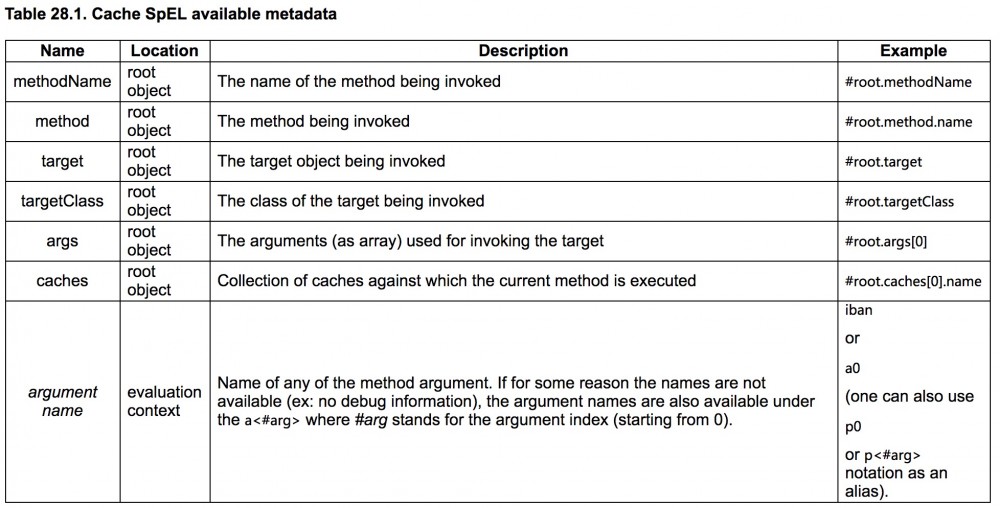spring对缓存的支持及相关注解说明
Spring 3.1 引入了基于注释(annotation)的缓存(cache)技术,但是它本质上不是一个具体的缓存实现方案(例如 EHCache 或者 OSCache),而是一个对缓存使用的抽象,通过在既有代码中添加少量它定义的各种annotation,即能够达到缓存方法的返回对象的效果。
Spring 的缓存技术还具备相当的灵活性,不仅能够使用 SpEL(Spring Expression Language) 来定义缓存的 key 和各种 condition ,还提供开箱即用的缓存临时存储方案,也支持和主流的专业缓存例如 EHCache 集成。
一个例子
先从一个例子来直观感受一下spring Cache 如何使用。
相关类
@Data
public class Product {
private Long id;
private String name;
}
public interface ProductDao extends MongoRepository<Product, Long> {
User findById(Long id);
List<User> findByName(String name);
}
@Service
public class ProductService {
@Resource
private ProductDao productDao;
@Cacheable(cacheNames = {"products"}, key = "#id")
public Product getProductById(Long id) {
return productDao.findById(id);
}
}
说明
方法 getProductById 上加了注解 @Cacheable ,表示该方法的返回值是可以被缓存的。
属性 cacheNames 或 value 作用相同,都是用来指定返回结果保存到哪个缓存中的,属性 key 用来指定缓存结果对应的 key (缓存通常都是key-value结构)。在改例中,key是由参数 id 进行计算的。
Cacheable 详解
@Cacheable 注解是Spring Cache中最重要的注解,它的配置属性如下:
value
指定方法返回结果保存到的缓存名称。作用和 cacheNames 相同。支持 数组 配置
cacheNames
参考 value 属性解释
key
属性 key 的类型是字符串,格式为 SpEL 表达式,用来动态计算缓存结果的 键 值。默认值为空,意味着所有的方法参数都会参与计算。
keyGenerator
该属性指定自定义 KeyGenerator 的Bean的名称。默认值为空,意味着使用 SimpleKeyGenerator
cacheManager
类型为: org.springframework.cache.CacheManager 的bean的名称。该bean需要我们在spring配置文件中配置。在SpringBoot中,如果检测到有对应的缓存框架,则会自动配置一个名称为 cacheManager 的bean。
cacheResolver
类型为: org.springframework.cache.interceptor.CacheResolver 的bean的名称。
condition
类型为字符串,结果是SpEL表达式,指定缓存的条件。默认值为空字符串,意味着方法的返回值总是被缓存。
unless
类型为字符串,结果是SpEL表达式,和 condition 不同的是,该表示式是在方法调用会进行计算的,用来否决方法的缓存。默认是空字符串,意味着从来不否决缓存结果。
sync
类型是boolean,4.3版本开始支持。表示在多个线程同时 加载 同一个缓存key对应的资源时,是否进行同步。默认值为false。
如果设置为true, 则能避免重复加载。该属性的功能能否起作用取决于如下条件:
- 不支持unless
- 只能指定一个缓存(cacheName取值唯一)
- 不能和其它缓存相关的操作进行组合
缓存key的计算规则
上面提到缓存 key 的格式为SpEL表达式。默认的计算规则如下:
- 如果方法没有参数,则返回0
- 如果方法只有一个参数,则返回该参数。
- 如果方法有多余一个参数,则key的值由所有参数的hashcode计算而来。具体可以参考
SimpleKeyGenerator
KeyGenerator
KeyGenerator 接口用来计算方法返回值对应的缓存键的值。
public interface KeyGenerator {
Object generate(Object target, Method method, Object... params);
}
spring默认提供了两个实现类: DefaultKeyGenerator (4.0版本开始不推荐使用) 和 SimpleKeyGenerator (默认使用)。
我们可以通过实现该接口自定义实现。
key SpEL 举例
@Cacheable(value="books", key="#isbn" public Book findBook(ISBN isbn, boolean checkWarehouse, boolean includeUsed) @Cacheable(value="books", key="#isbn.rawNumber") public Book findBook(ISBN isbn, boolean checkWarehouse, boolean includeUsed) @Cacheable(value="books", key="T(someType).hash(#isbn)") public Book findBook(ISBN isbn, boolean checkWarehouse, boolean includeUsed)
SpEL语法可以参考: Chapter 7, Spring Expression Language (SpEL)
条件缓存
@Cacheable(value="book", condition="#name.length < 32") public Book findBook(String name)
SpEL计算上下文

@CachePut
如果缓存需要更新,且不干扰方法的执行,可以使用注解 @CachePut 。 @CachePut 标注的方法在执行前不会去检查缓存中是否存在之前执行过的结果,而是每次都会执行该方法,并将执行结果以键值对的形式存入指定的缓存中。
@CachePut(cacheNames="book", key="#isbn") public Book updateBook(ISBN isbn, BookDescriptor descriptor)
注意:应该避免@CachePut 和 @Cacheable同时使用的情况。
@CacheEvict
spring cache不仅支持将数据缓存,还支持将缓存数据删除。此过程经常用于从缓存中清除过期或未使用的数据。
@CacheEvict 要求指定一个或多个缓存,使之都受影响。此外,还提供了一个额外的参数 allEntries 。表示是否需要清除缓存中的所有元素。默认为 false ,表示不需要。当指定了 allEntries 为 true 时,Spring Cache将忽略指定的key。有的时候我们需要Cache一下清除所有的元素。
@CacheEvict(cacheNames="books", allEntries=true) public void loadBooks(InputStream batch)
清除操作默认是在对应 方法成功执行之后 触发的,即方法如果因为抛出异常而未能成功返回时也不会触发清除操作。使用 beforeInvocation 可以改变触发清除操作的时间,当我们指定该属性值为true时,Spring会在调用该方法之前清除缓存中的指定元素。
@CacheEvict(cacheNames="books", beforeInvocation=true) public void loadBooks(InputStream batch)
@CacheConfig
有时候一个类中可能会有多个缓存操作,而这些缓存操作可能是重复的。这个时候可以使用@CacheConfig
@CacheConfig("books")
public class BookRepositoryImpl implements BookRepository {
@Cacheable
public Book findBook(ISBN isbn) {...}
}
@CacheConfig 是一个类级别的注解,允许共享缓存的名称、KeyGenerator、CacheManager 和CacheResolver。
该操作会被覆盖。
开启缓存注解
java类配置:
@Configuration
@EnableCaching
public class AppConfig {
}
XML 配置
<beans xmlns="http://www.springframework.org/schema/beans"
xmlns:xsi="http://www.w3.org/2001/XMLSchema-instance"
xmlns:cache="http://www.springframework.org/schema/cache"
xsi:schemaLocation="
http://www.springframework.org/schema/beans http://www.springframework.org/schema/beans/spring-beans.xsd
http://www.springframework.org/schema/cache http://www.springframework.org/schema/cache/spring-cache.xsd">
<cache:annotation-driven />
</beans>
配置CacheManager
CacheManager是Spring定义的一个用来管理Cache的接口。Spring自身已经为我们提供了两种CacheManager的实现,一种是基于Java API的ConcurrentMap,另一种是基于第三方Cache实现——Ehcache,如果我们需要使用其它类型的缓存时,我们可以自己来实现Spring的CacheManager接口或AbstractCacheManager抽象类。下面分别来看看Spring已经为我们实现好了的两种CacheManager的配置示例。
基于ConcurrentMap的配置
<bean id="cacheManager" class="org.springframework.cache.support.SimpleCacheManager">
<property name="caches">
<set>
<bean class="org.springframework.cache.concurrent.ConcurrentMapCacheFactoryBean" p:name="xxx"/>
</set>
</property>
</bean>
```
上面的配置使用的是一个SimpleCacheManager,其中包含一个名为“xxx”的ConcurrentMapCache。
#### 基于Ehcache的配置
```xml
<bean id="cacheManager" class="org.springframework.cache.ehcache.EhCacheCacheManager" p:cache-manager-ref="ehcacheManager"/>
<bean id="ehcacheManager" class="org.springframework.cache.ehcache.EhCacheManagerFactoryBean" p:config-location="ehcache-spring.xml"/>
上面的配置使用了一个Spring提供的EhCacheCacheManager来生成一个Spring的CacheManager,其接收一个Ehcache的CacheManager,因为真正用来存入缓存数据的还是Ehcache。Ehcache的CacheManager是通过Spring提供的EhCacheManagerFactoryBean来生成的,其可以通过指定ehcache的配置文件位置来生成一个Ehcache的CacheManager。若未指定则将按照Ehcache的默认规则取classpath根路径下的ehcache.xml文件,若该文件也不存在,则获取Ehcache对应jar包中的ehcache-failsafe.xml文件作为配置文件。更多关于Ehcache的内容这里就不多说了,它不属于本文讨论的内容,欲了解更多关于Ehcache的内容可以参考我之前发布的Ehcache系列文章,也可以参考官方文档等。
- 本文标签: API key db 删除 id map 注释 Java类 https Service 缓存 管理 XML classpath http IO cat 时间 参数 git Property mongo 数据 HTML update src 数据缓存 线程 代码 list ip 文章 本质 UI App java schema cache find GitHub value ACE springboot 配置 CTO spring 同步 tar bean
- 版权声明: 本文为互联网转载文章,出处已在文章中说明(部分除外)。如果侵权,请联系本站长删除,谢谢。
- 本文海报: 生成海报一 生成海报二











![[HBLOG]公众号](https://www.liuhaihua.cn/img/qrcode_gzh.jpg)

